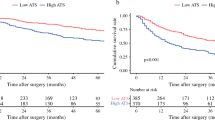Abstract
Background
The prognosis of HCC depends in large measure on maximum tumor diameter (MTD).
Aims
To examine characteristics of tumor aggressiveness over an MTD range of < 2 to 8 cm.
Methods
A large HCC database was examined retrospectively for trends in serum alpha-fetoprotein (AFP), and percent of patients with macroscopic portal vein thrombosis (PVT) or tumor multifocality.
Results
There was a significant trend to increased serum AFP levels and percent of patients with PVT, for each, p < 0.001. Within those trends, there were clearly identifiable sub-trends for variations of AFP or percent PVT patients, associated with specific MTD ranges. Calculation of the fold increase for either AFP or percent PVT patients over distinct MTD ranges showed a greater increase of AFP or percent PVT patients compared with the related MTD increase. Interestingly, the increase in percent PVT was mainly independent of AFP.
Conclusions
Patterns of AFP and PVT increase can be discerned with increasing MTD, which are nonlinear. The greater fold increase in tumor aggressiveness factors compared with MTD suggests that HCCs may change with increasing size to a more aggressive phenotype. Baseline HCC biopsies might therefore be insufficient in future rational HCC management, and repeated liquid biopsies have potential in following HCC evolution and thus choices of therapies.


Similar content being viewed by others
Abbreviations
- HCC:
-
Hepatocellular carcinoma
- PVT:
-
Macroscopic portal vein thrombosis
- AFP:
-
Alpha-fetoprotein
- MTD:
-
Maximum tumor diameter
- CT:
-
Computerized axial tomography scan
References
Mazzaferro V, Regalia E, Doci R, Andreola S, Pulvirenti A, Bozzetti F, et al. Liver transplantation for the treatment of small hepatocellular carcinomas in patients with cirrhosis. N Engl J Med. 1996;334:693–9.
Yao FY, Ferrell L, Bass NM, Watson JJ, Bacchetti P, Venook A, et al. Liver transplantation for hepatocellular carcinoma: expansion of the tumor size limits does not adversely impact survival. Hepatology. 2001;33(6):1394–403.
Llovet JM, Pavel M, Rimola J, Diaz MA, Colmenero J, Saavedra-Perez D, et al. Pilot study of living donor liver transplantation for patients with hepatocellular carcinoma exceeding Milan Criteria (Barcelona Clinic Liver Cancer extended criteria). Liver Transpl. 2018;24:369–79.
Ince V, Akbulut S, Otan E, Ersan V, Karakas S, Sahin TT, et al. Liver transplantation for hepatocellular carcinoma: Malatya experience and proposals for expanded criteria. J Gastrointest Cancer. 2020;51:998–1005.
Masayoshi T, Wakui N, Sumino Y. Use of radiofrequency ablation in the treatment of hepatocellular carcinoma: experience of ablation protocols. Exp Ther Med. 2012;4:959–61.
Ishii H, Okada S, Nose H, Okusaka T, Yoshimori M, Takayama T, et al. Local recurrence of hepatocellular carcinoma after percutaneous ethanol injection. Cancer. 1996;77:1792–6.
Suner A, Carr BI, Akkiz H, Üsküdar O, Yalçın K, et al. Inflammatory markers C-reactive protein and PLR in relation to HCC characteristics. J Transl Sci. 2019;5(3). https://doi.org/10.15761/JTS.1000260.
Carr BI, Akkiz H, Guerra V, Üsküdar O, Kuran S, et al. C-reactive protein and hepatocellular carcinoma: analysis of its relationships to tumor factors. Clin Pract (London). 2018;15:625–34.
Carr BI, Guerra V. A hepatocellular carcinoma aggressiveness index and its relationship to liver enzyme levels. Oncology. 2016;90:215–20.
Carr BI, Guerra V, Giannini EG, Farinati F, Ciccarese F, et al. A liver index and its relationship to indices of HCC aggressiveness. J Integr Oncol. 2016;5:178. https://doi.org/10.4182/2329-6771.1000168.
Utsonomiya T, Shimada M, Imura S, Morine Y, Ikemoto T, et al. Molecular signatures of noncancerous liver tissue can predict the risk of late recurrence of hepatocellular carcinoma. J Gastroenterol. 2010;45:146–52.
Nault J-C, De Reynies A, Villanueva A, Caldero J, Rebouissou S, et al. A hepatocellular carcinoma 5-gene score associated with survival of patients after liver resection. Gastroenterology. 2013;145:176–87.
Pancoska P, Lu S-N, Carr BI. Phenotypic categorization and profiles is small and large hepatocellular carcinomas. J Gastrointest Dig Sys. 2013. https://doi.org/10.4172/2161-069X.S12-001.
Carr BI, Pancoska P, Branch RA. Tumor and liver determinants of prognosis in unresectable hepatocellular carcinoma: a large case cohort study. Hepatol Int. 2009;4:396–405.
Duan M, Hao J, Cui S, Wortley DL, Zhang S, et al. Diverse modes of clonal evolution in HBV-related hepatocellular carcinoma revealed by single-cell genome sequencing. Cell Res. 2018;28:359–73.
Craig AJ, von Felden J, Garcia-Lezana T, Sarcognato S, Villanueva AS. Tumor evolution in hepatocellular carcinoma. Nat Rev Gastroenterol Hepatol. 2020;17:139–52.
Castelli G, Pelosi E, Testa U. Liver cancer: molecular characterization, clonal evolution and cancer stem cells. Cancers (Basel). 2017;9:127. https://doi.org/10.3390/cancers9090127.
Funding
This work was supported in part by the NIH grant CA 82723 (B.I.C).
Author information
Authors and Affiliations
Contributions
BIC: concept, ideas, and writing
VG and RD: biostatistics
All authors have read and agree with this paper.
Corresponding author
Ethics declarations
Conflict of interest
The authors declare that they have no conflict of interest.
Statement of Ethics
This work complies with the guidelines of the World Medical Association, Declaration of Helsinki. This work was approved by the institution’s IRB as documented in the methods section.
Additional information
Publisher’s Note
Springer Nature remains neutral with regard to jurisdictional claims in published maps and institutional affiliations.
Rights and permissions
About this article
Cite this article
Carr, B.I., Guerra, V., Donghia, R. et al. Trends in Tumor Indices in Relation to Increased Hepatocellular Carcinoma Size: Evidence for Tumor Evolution as a Function of Growth. J Gastrointest Canc 51, 1215–1219 (2020). https://doi.org/10.1007/s12029-020-00530-9
Accepted:
Published:
Issue Date:
DOI: https://doi.org/10.1007/s12029-020-00530-9




